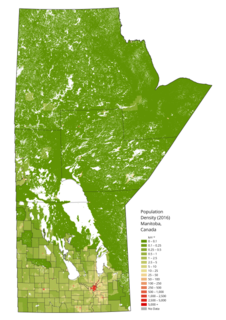
A designated place is a type of geographic unit used by Statistics Canada to disseminate census data. [1] It is usually "a small community that does not meet the criteria used to define incorporated municipalities or Statistics Canada population centres (areas with a population of at least 1,000 and no fewer than 400 persons per square kilometre)." [2] Provincial and territorial authorities collaborate with Statistics Canada in the creation of designated places so that data can be published for sub-areas within municipalities. [2] Starting in 2016, Statistics Canada allowed the overlapping of designated places with population centres. [2]
Contents
At the 2016 Census of Population, Manitoba had 135 designated places, [3] an increase from 97 in 2011. [4] Designated place types in Manitoba include 2 dissolved municipalities, 44 local urban districts, 46 northern communities, and 43 unincorporated urban centres. [5] In 2016, the 135 designated places had a cumulative population of 63,973 and an average population of 474. Manitoba's largest designated place is Lorette with a population of 3,208. [5]


